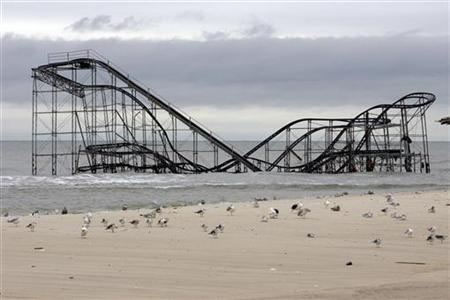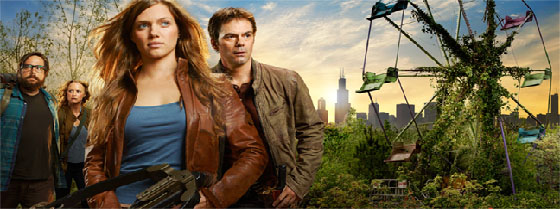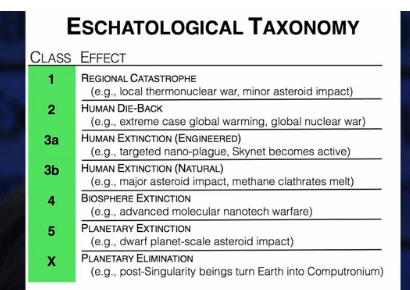It probably means something that my last post of 2012 was on resilience and one of my first posts of 2013 is on apocalypse. Perhaps I’ve got things backwards.
Do I know how to have a good time or what? I usually spend my late nights skimming through a way-too-long list of blogs, primarily on eco topics, slowing to read the ones that pique my interest. But the nearly two-week long end of the year holiday period managed to slow the number of incoming posts each night from well over 200 to a giddyingly time-freeing amount in the mid-two digits. So what did I do with the leftover time? I read not one, but two, anthologies of post-apocalyptic short stories. That’s what I mean about knowing how to have a good time. Some folks curl up with a good mystery. Me? I prefer evenings of vignettes and variants on themes the likes of Mad Max and Soylent Green. (Maybe not Zardoz, though. I do have standards.)
Hard to tell if this is a scene from a disaster movie or the evening news. Image source: news.yahoo.com
This has nothing to do with the Mayan or various other supposed prophesies. Why then this interest from the self-anointed EcoOptimist? Life after the apocalypse is not exactly positive, not in the sense of EcoOptimism or of much of anything for that matter. Sure some post-apocalypse worlds are freed of the ravages of humanity and can return to a more balanced ecosystem, but that’s not exactly the path EcoOptimism has in mind.
I know many designers and many environmentalists who are fans of science fiction, which makes a lot of sense. I hope to elaborate on that in the future (or at least in a parallel future), but the basic point is that design is inherently optimistic in that it consists of attempts to improve things – creating futures — and so is most science fiction. But post-apocalyptic scenarios are a specific subset of science fiction. Where SF is more often based on StarTrek-like worlds in which humans are smarter and life is better (though there’s still plenty of room for wars and mysteries), stories that are based on what remains after a plague or a nuclear winter or the second coming (yes, those scenarios exist, too) tend to be much less filled with cool gadgets and warp drives, and more about sheer survival.
If our current world is anthropocentric (a new term has been coined for this period of geological time in which the planet is being shaped not by nature but by humanity: the Anthropocene), environmentalists usually envision one that is biocentric or ecocentric: giving equal weight to all living things – and perhaps some non-living things as well. A world after an apocalypse, however, is more likely to be a misanthropic one — one that by default or otherwise puts the interests and strength of nature above humanity’s. Maybe it’s that alternative view of the primacy of humans that sets me thinking. I like things that shake me up and, in this case especially, better that it be through fiction than the real thing.
Apocalypses seem to be everywhere these days. Even putting aside the Mayan misinterpretation (as well as that guy who predicted the Rapture not once but twice in 2011), there’s a run on ends of the world. Movies, books, television shows. Fact and fiction. It may not be high quality (the revolution may not be televised and Revolution probably shouldn’t have been), but it does constitute a full blown genre.
NBC’s Revolution: apocalyptically bad? What a waste of an end of the world. Image source: techhive.com
At its most fundamental, creating stories of our future demise or near demise (in many of these stories, there are scraggly bands of survivors) can be seen as an exercise in avoidance. If we can anticipate what’s going to go wrong, then we should be able to avoid it. Nuclear war might be an example. At least I hope it is. I’m not sure whether “the Rapture” is or should be avoidable – or what steps one would take to do so – but man-made future cataclysms ought to be. Do we really think, though, that any of the made-for-SyFy movies are going to convince the climate skeptics? (Facts don’t seem to sway them; maybe fiction can.)
Future prognostications don’t have to end badly. Indeed, many such stories have the survivors, well, surviving. Some have used the genre to posit what they feel would be positive outcomes. Ernest Callenbach’s Ecotopia stories, in which the Pacific Northwest has seceded from the dysfunctional rest of the country, come to mind.
But John Michael Greer’s view is more typical, if you can describe anything about an environmentalist, author, historian and neo-Druid who writes on topics ranging from UFOs to peak oil to the occult as typical. In his non-fiction book, The Ecotechnic Future, as well as his online serialized novel Star’s Reach, he makes the point that our industrial age advances are entirely based on the easy availability of cheap energy and materials. If we were to create or encounter an apocalypse that sent us back into a pre-industrial age, therefore, it would be pretty much impossible, because the easily accessed energy and materials would have been used up, for us to do it again.
Jamais Cascio of Open the Future has spoken on apocalypses and how we envision our future, dwelling on what he calls legacy futures. An example of a legacy future, he says, is the jet pack – it’s what we expected the future to have. “The apocalypse [or] the catastrophic tomorrow,” he observes, “is the cornerstone legacy future.” I’m not sure he’s right. Is it what we really expect to happen? Are we such fatalists? “[These stories] leave us disempowered, discouraged and feeling doomed.” I won’t claim to represent all of us, but the stories and movies don’t affect me that way. What they do do is inject, in as much as fiction can, an element of reality, something relatable: this could happen. And could happen to people like us.
Jamais Cascio’s categorization of possible apocalypse causes
So why do I enjoy these less-than-heartwarming stories? I’d like to think it’s in order to see wiser paths, like a Grimm fable without the later Disneyfication. But it may simply be that they provide an escape, albeit a perverse one: let’s get away from the potential end of the world problems by immersing in fictional scenarios of same.
Cascio makes the point that human beings, alone among other species (at least that we know of), have evolved to think about the future. (I don’t think squirreling away acorns counts.) When we create stories of the end of the world, he says, “they serve to tell us we live on a fragile planet and it is extremely possible we could break it and destroy it.” Yes, but I don’t think that needs to be perceived as disempowering or discouraging. The purpose of warnings, fictional or otherwise, is to help us avoid the danger. We wouldn’t ponder whether we need measures to destroy incoming asteroids if we didn’t have whiz-bang movies depicting the possibility, and if we didn’t have the pure bang of the impact that killed off the dinosaurs.
Ellen LaConte, in the Resilience blog, writes “How about, let’s pretend the world’s worsening weather is a threat akin to a pending asteroid collision, because, though its effects will be less sudden and simultaneous, it is. How about we call it ‘Global Warning.’”
There’s at least one difference between the actions we’d take to avoid death-by-asteroid and what’s needed to diminish and/or adapt to climate disruption. Asteroid avoidance would involve spending large amounts of money and resources merely to sustain our existence. The technological and social responses to climate disruption and resource depletion, on the other hand, have the potential to not merely sustain but to better our lives, while simultaneously having a positive return on investment. And that’s a major part of the point of EcoOptimism – that these are desirable things to do even if we didn’t have the specter of climatic apocalypse shoving us in their direction.



